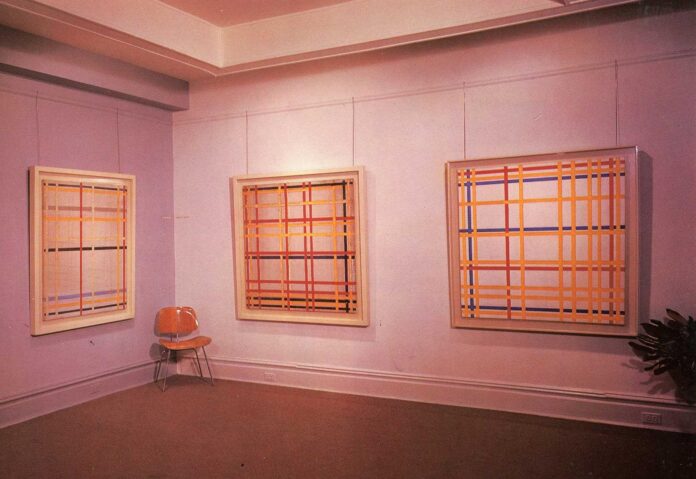Headlines fluttered around the globe several months ago that a late and unsigned Piet Mondrian painting had been hanging upside down for 75 years and a curator in the German museum where it resides made the case it was an art-historical blooper.
The evidence that caused the brouhaha stemmed from the discovery of a fashion photograph in the June 1944 issue of Town & Country magazine that featured a model in Mondrian’s studio with the painting in question, New York City 1 (Unfinished) (1941), resting on the artist’s easel 180 degrees opposite to the way it currently hangs. The issue came out four months after the artist’s death at age 71, so presumably the studio fashion shoot took place posthumously.
The controversy started rolling after Francesco Visalli, the Italian conceptual artist and Mondrian aficionado, brought the photograph, by the fashion photographer Fernand Foussagrives, to the attention of Susanne Meyer-Büser, a curator at the Kunstsammlung Nordrhein-Westfalen in Düsseldorf, which owns the canvas.
However, in the Mondrian catalogue raisonné of 1998 by Joop Josten, the author cites Foussagrives’s photograph as reproducing the painting “upside down”.
Without any indication from Mondrian as to which way is indeed “up”, the art dealer Carroll Janis—the son of the famous gallerist and museum patron Sidney Janis, who bought Mondrian’s entire painting estate in 1958 from the artist Harry Holtzman—says those who visited Mondrian in the studio “would have the best idea of what ‘up’ is”.
He adds: “But actually, if you turn any of these late paintings upside down they don’t look right. They still only look right right side up.”
Janis also explains the important role Holtzman played in Mondrian’s life, first bringing him to New York from London during the Second World War, finding him an apartment and studio and, perhaps more importantly, bringing him the coloured tapes that the artist began to use in his late paintings, abandoning his brush.
“Mondrian did accept the tapes and Harry told me,” Janis says, “that one time he even helped the artist put the tapes on the painting because it was a big, physical job—so Harry was right there and he was important to the artist, as close as a comrade he had in New York.”
New York City 1 (Unfinished) was exhibited at the Sidney Janis Gallery on West 57th Street in New York in 1957 and 1962, and installation photographs of the exhibitions show the geometric painting with its taut horizontal and vertical lines in primary colours hung the way Holtzman and Janis had seen it in the artist’s studio, and the same way it has been hung for the past 75 years.
Gravity’s pull
“To me,” Janis says, “upside down, it looks like a Venetian blind that is pulled up towards the top. When you turn it right side up, the lines are at the bottom, giving it a kind of gravitational element. I don’t see how anyone could think you could turn it upside down.”
The painting stayed with the Sidney Janis Gallery until 1980 when the Swiss art dealer Ernst Beyeler acquired it and quickly resold it to the Kunstsammlung in Düsseldorf.

Sidney Janis bought the entire estate of Mondrian (right) from Harry Holtzman (left) in 1958
© Estate of Harry Holtzman
“I am 100% certain the picture is the wrong way around,” Meyer-Büser told The Guardian newspaper last October, adding: “If you were to turn it upside down now, gravity would pull it into another direction. And it’s now part of the work’s story.”
In early January this year, a spokesperson for the museum put another curatorial spin on the painting: “We do not claim that the painting is hanging ‘wrongly’, but that it is hanging differently than it appeared in the photograph in the studio ‘upside down’, so to speak. Ultimately, we simply do not know what the final artistic decision of Mondrian was.”
The spokesperson added: “The painting will continue to hang in the museum as it entered the collection in 1980. The question of whether the painting is ‘upside down’ today is now part of the history of the work.”

























